

We begin our survey of the solar system at home, with a
closer examination of the Earth-Moon system. We have learned that the Moon
orbits around the Earth on a (almost) monthly basis. First, let's talk some
numbers. The equatorial radius of the Earth is 6,378 km, while the Moon
has a radius of 1,738 km. The volume of a sphere is 4piR3/3,
thus the Earth has 49 times the volume of the Moon. If the densities of
the Earth and Moon were identical (they are not), the Earth would be 49
times more massive. In fact, the mass of the Earth is 5.97 X 1024 kg,
and the mass of the Moon is 7.35 X 1022 kg. The Earth is 81 times
more massive than the Moon, thus the Earth is 81/49 = 1.7 times more dense.
The Moon is quite insignificant when compared directly to the Earth, but
we will learn that the Moon is a significant solar system body in its own rite.
You might wonder why I bring up the subject of density--it is density which
allows you to examine the composition of a planet. Remember that density
is simply Mass divided by Volume. The units of density are normally expressed
as grams per cubic centimeter (or sometimes as kg per cubic meter). Water has
a density of 1 gram per cubic centimeter (the definition!). Using the
numbers above, we find that the density of the Earth is 5.5
grams/cm3. As you know from common experience, rock is denser than
water and does not float! Most rocks on the surface of the Earth are
silicates, that is they contain mostly silicon and other elements (such as
oxygen) . The density of pure silicon is 2.3 gm/cm3. The
mean density of the Earth is higher than this, so it must have something
heavier below its surface--hmmm, maybe iron? The density of iron is 7.7 gm/cm3.
Thus, the mean density of the Earth is just about halfway between pure silicon
and pure iron. Where is all of this iron? Well some of it is on the surface,
as we have iron-rich deposits that are mined for everyday uses. The
rest lies below the Earth's surface.
Through the analysis of earthquakes (see page 257 of the text),
we can probe the inside of the Earth. Using these techniques, we now have a
picture of the structure of the Earth. The
thin, outermost layer of the Earth is called the "crust". The crust is
very thin, between 6 and 70 km thick. Note that the equatorial
radius of the Earth is 6378 km, so the crust represents less than 1% of the
radius of the Earth--it is truly just a "skin". The crust is cold and brittle,
and thus can
fracture (causing earthquakes). The crust is made up of large slabs
of rock called "plates". There are two types of crust/plate material,
"Continental" and "Oceanic". The oceanic material is denser because it
formed from volcanic material. It is also younger (the oldest parts are only
200 Myr old), and thinner (about 6 to 10 km thick). The continental crust is
older (up to 3.5 billion years old), and thicker (35 to 70km).
Below the crust is the mantle. The mantle is about 2,900 km thick. The upper
parts are solid, while the lowest parts are "plastic-like" and can flow.
Hotter portions of the mantle can rise up towards the surface where they cool
and then sink back towards the center.
Below the mantle is the "core". There are two parts to the core, an outer
liquid region where the temperature is about 4000o, and an inner
region where the extreme pressures force the liquid to act like a solid:
The top-most layers of the Earth, that include both the crust, and the solid part of the mantle are called the lithosphere:
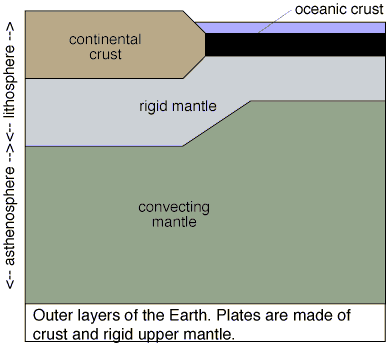
In the mantle, convective motions ("boiling") appear to move material around, and this motion helps drive the plate tectonics, the process that pushes the continents around the planet. For example, where hotter material rises to the lithosphere, pressure is exerted, and magma is forced to the surface causing the spreading seen in the ocean floor. Alternatively, where the mantle material is sinking, it can drag crustal material downwards ("slab pull"), causing an oceanic trench, and pulling the continents toward this subduction zone:
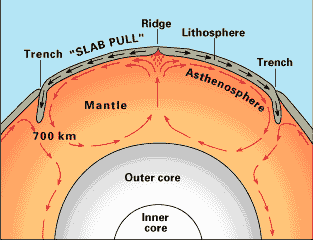
Both slab pull and upward ridge pressure act together to drive the continental drift. The continental drift creates mountain ranges, and is responsible for most earthquakes and volcanoes on the Earth. One example is the creation of the Himalayas by the force of the India plate running into the Eurasian plate over the last 70 million years:
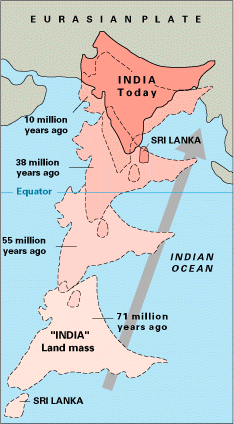
The pressure of this collision compresses part of the crust of the Indian plate, causing it to rise up to form the Himalayas. As the Indian plate is subducted below the larger, more massive Eurasian plate, parts of the Eurasian plate are up-lifted to form the Tibetan plateau:
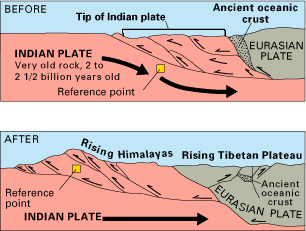
Where the North American plate is colliding with the Pacific Plate, and where the Pacific plate collides, and is subducted under the Eurasian plate, we have the northern portion of the famous "ring of fire", a nearly continuous zone of sesimic and volcanic activity:
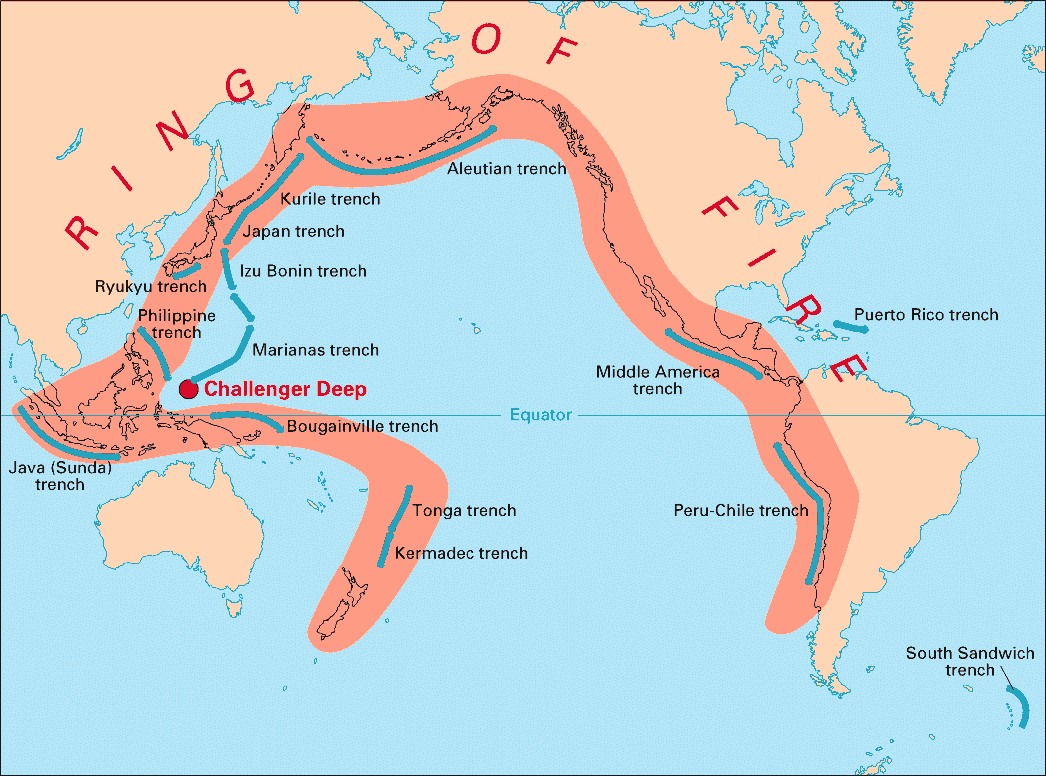
[Continental drift movie link.]
In other places, apparently fixed "hot spots" in the mantle exist, and here hotter material can reach the surface creating an island chain like Hawaii:
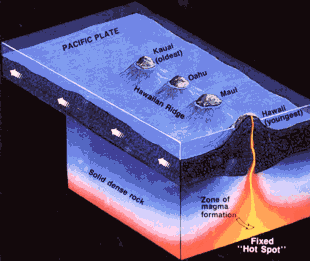
Where does all of this heat come from? It is not clear exactly why the core of the Earth remains so hot (to understand how we know about the Earth's core, go here). Evidence suggests that the tectonic plates are becoming thicker, this is evidence that the Earth is cooling. Most of the heat we see at the center of the Earth comes from the earliest history of the Earth, when the entire planet was molten rock. So, much of the heat at the center of the Earth is left over from the time of formation. As bodies collided with the young Earth, they added energy. The increase in mass caused by the accretion of these objects, increases the pressure, and generates more heat. In addition, radioactive decay in the center adds heat. Because rock is a good insulator (it doesn't conduct heat well), this heat remains trapped (a more technical treatise on this subject can be found here, while section 10.2 of our text describes the heating and cooling process).
Plate tectonics and volcanic activity shape the surface of the Earth. Mountains are pushed up where plates collide, while some crust is recycled into the mantle. Thus new geological features are constantly appearing on the planet, while others disappear. For example, a large volcano can spew out lava and ash and bury valleys and lakes. This constant recycling of the surface is one reason why the Earth's appearance differs from the other rocky ("terrestrial") planets. The other major force changing the surface of the planet is erosion from wind and rain.
Shortly after the Earth formed and began to cool, it was likely that the Earth had no atmosphere. Our modern-day atmosphere is believed to be due to "outgassing" from volcanoes. The early atmosphere was probably dominated by water vapor, nitrogen, and carbon dioxide. There was very little free oxygen. The condensation of the water vapor formed the oceans, and photosynthesis by plants created the oxygen:

The composition of the Earth's atmosphere is quite unusual compared to the other planets. It is about 78% nitrogen, 21% oxygen. The remaining trace elements/molecules are argon (< 1%), water vapor (0 to 7%: altitude dependent), ozone (<0.01%), and carbon dioxide (<0.1%). With an atmosphere to blow dust around and water to fall from the sky and dig valleys, the surface of the Earth is constantly being eroded-away. These forces (including the movement of glaciers) causes the Earth's surface to change over the eons since its birth. We will see this is not the case for the Moon.
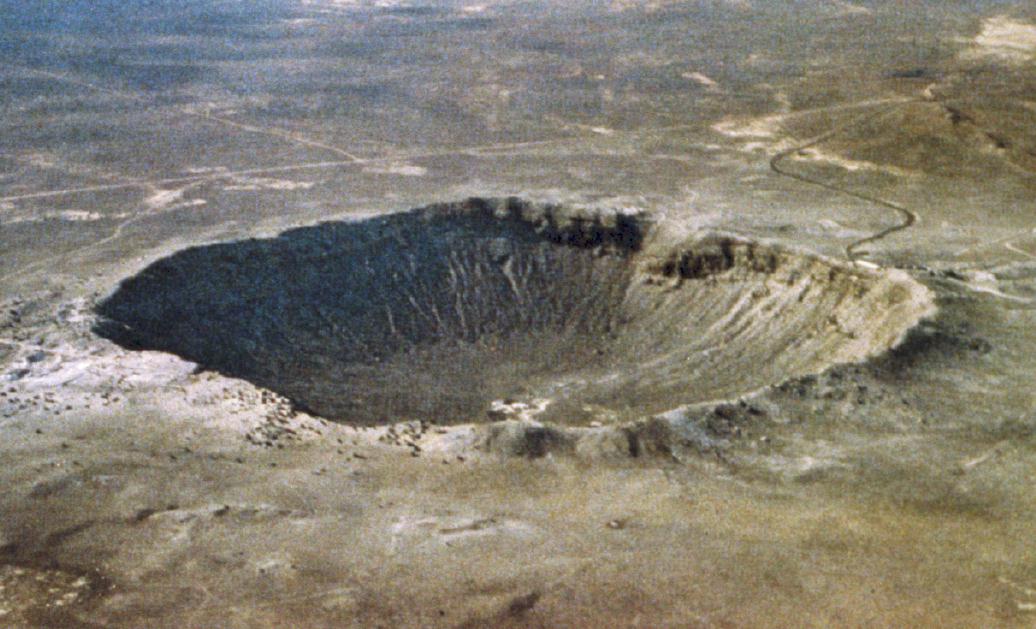
Sometime during this semester you will get a chance to look at the Moon through one of the telescopes at the campus observatory. One glance, and you quickly can see how different the surface of the Moon is from the Earth:
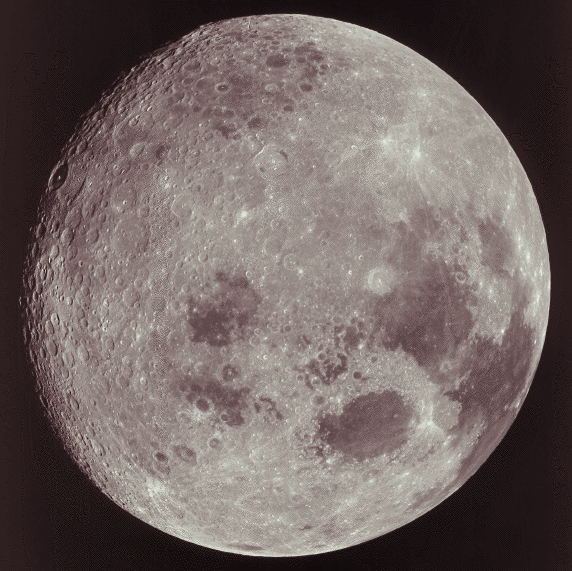
It has a very large number of round "craters", and large flat, dark plains called "Maria" (from the Latin for "sea"). The origin of most of these features are due to a single process: bombardment of the Moon by large rocks. As the solar system formed, there was an abundance of material left over, most of this was in the form gas and dust, and small "rocks". But there were some large bodies also. Eventually, all of this material ended-up crashing into the Sun, or onto some other planet or moon (note that comets and asteroids, which we will talk about in upcoming classes), are believed to be left over material from the earliest days of the solar system). It is this process that has shaped the surface of the Moon. Because the Moon has no atmosphere, and it does not have active volcanoes or plate tectonics, there are no processes to erase the craters left over from the bombardment phase. Thus, the surface of the Moon reflects the violent history of the early days of our solar system. Note that the Earth probably suffered even greater numbers of craters, but the erosion processes here erased MOST traces of such events.
Let's look at a lunar crater more carefully. Here is the lunar crater Copernicus (named after Nicholas):
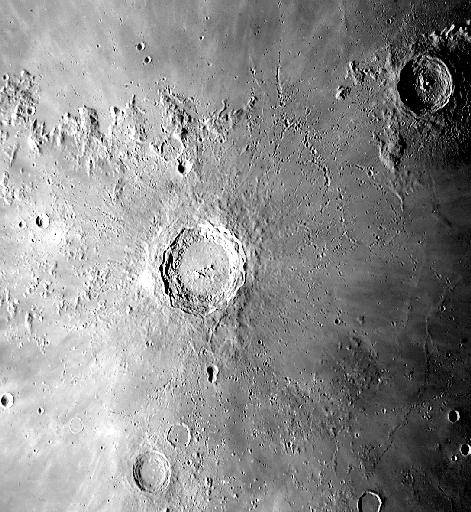
If you look carefully at this picture, you will see lots of radial features that emanate from the crater ("crater chains"). These smaller pockmarks are from material blasted out of the crater that fell on the surrounding surface creating hundreds of smaller craters. Copernicus is about 93 km across. Note how the surrounding plains have been disturbed by the impact. Near the center of the crater you can see some small mountain peaks. Here is a view taken by the Apollo 17 crew of Copernicus from a different angle than we can see on Earth:
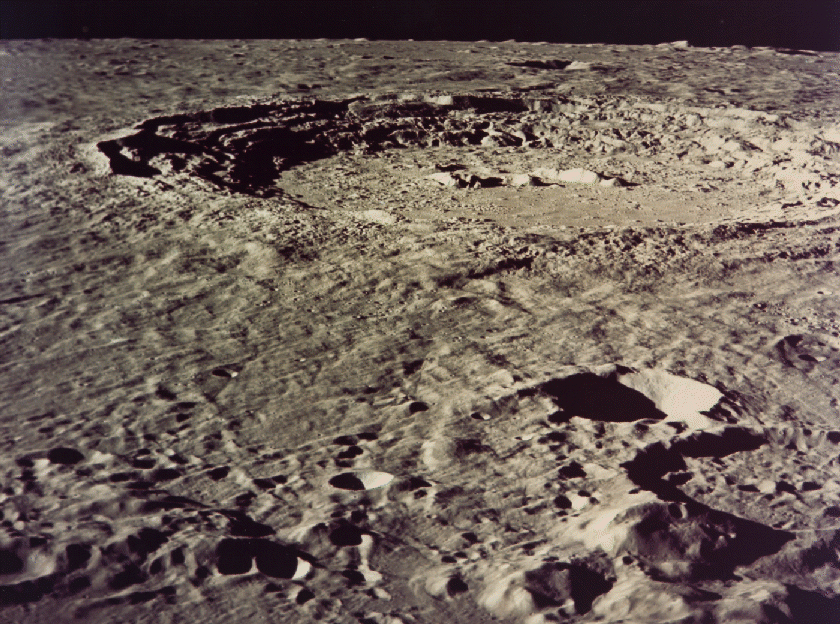
Now we can see the central hills/mountains more clearly. These peaks are about 1 km in height. So how does all of this structure form? Here is the basic process:
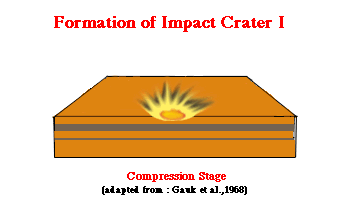
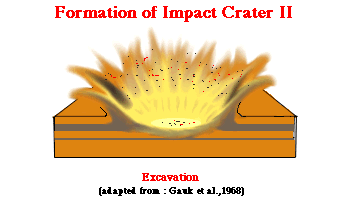
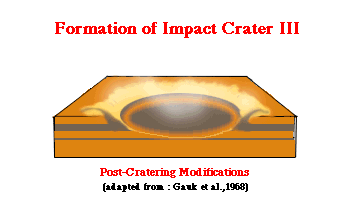
As the meteorite impacts the lunar surface it first compresses and heats the surface rocks, this then "rebounds" in a giant explosion that excavates the crater. Some material is ejected outwards forming rays and crater chains. Other material falls back in. Sometimes the central part rebounds and forms a central peak (or complex in the case of Copernicus). Here is the basic structure of craters:
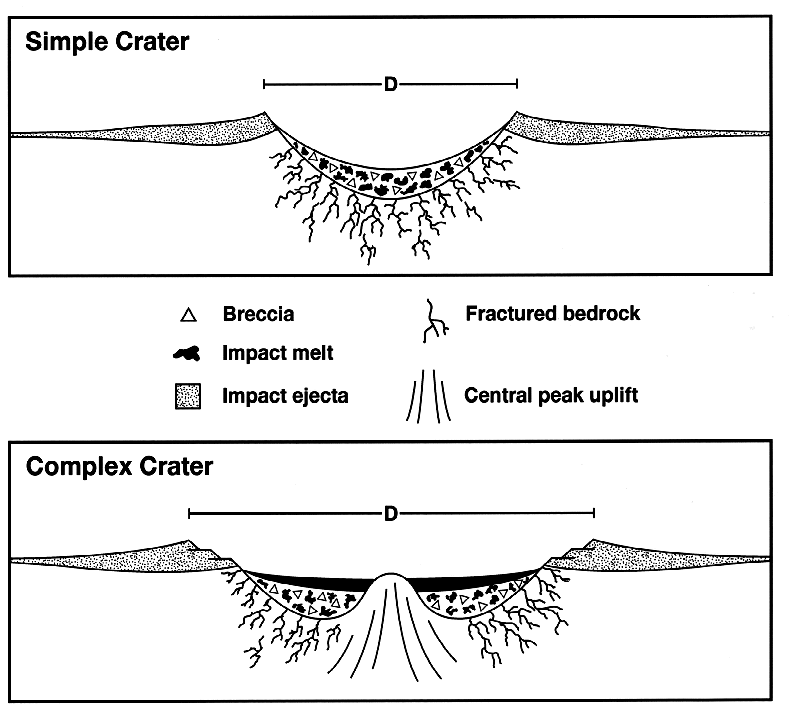
Here is a simple crater (Moltke):
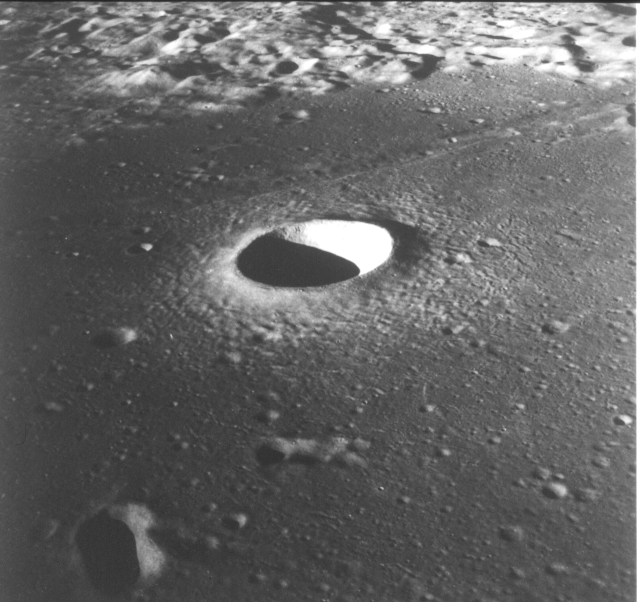
Here's another more complex crater (Euler):
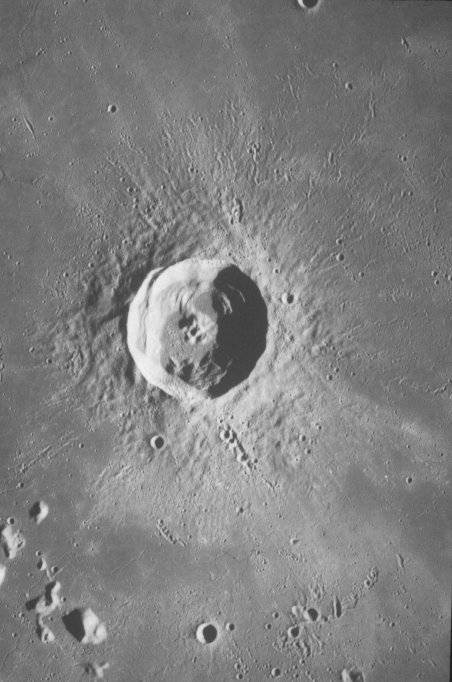
Simple craters result from smaller meteors impacting the Moon, while complex craters are the result of large impacts. The most dominant features on the Moon, those that are visible without a telescope, are the lunar maria. In this (nearly) full Moon image, the Maria are the large, dark regions:
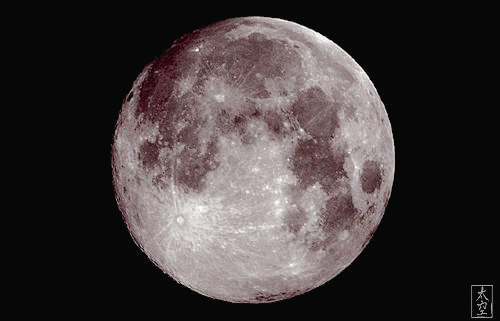
Here is a close up (below) of one of them, Mare Serenitatis (the Sea of Serenity, it can be located in the full Moon image above--it is the roughly circular dark region above and to the right of center):
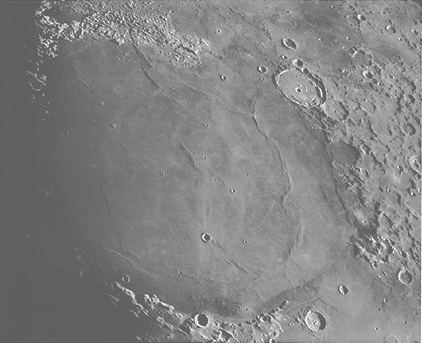
As this picture shows, the Maria are quite smooth---almost free of craters. As you learn in the Moon Lab exercise, the number of craters a particular region has indicates its age: more craters means that it is older. Why? Well, back when our solar system was young, there was a bunch of junk left over from the formation of the planets. This junk (rock, dust, etc.) was eventually "swept-up" by the planets and the Sun. So, the amount of material floating between the planets declined with time. In the early times, the planets were being bombarded with meteors, but this died off fairly quickly, and fewer, and fewer meteors were left to cause impact craters. Thus, the number of impact craters declined with time. Because maria have few craters, they MUST be younger than the surrounding regions. But, you ask, how is a maria formed? The same way the smaller craters are formed: by impact. But now the impacting body is very large, and it cracks the crust of the Moon and lava from the mantle of the Moon leaks up to the surface and floods the surrounding terrain. Here is a maria impact cartoon:
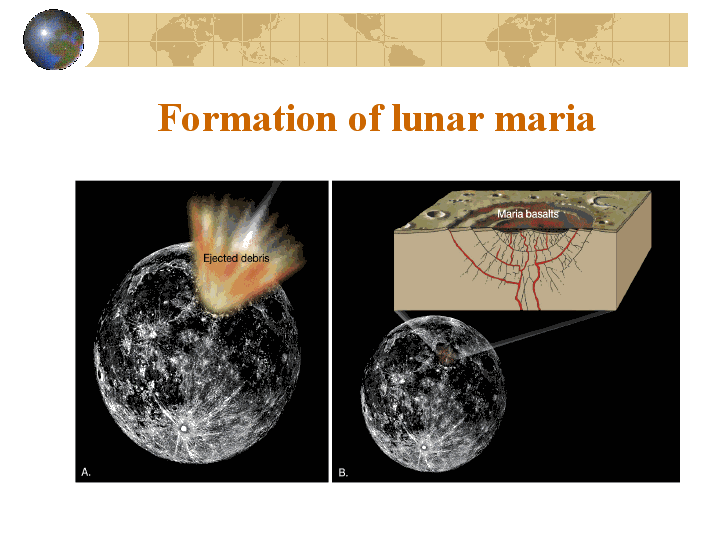
The cracks in the crust (the red/orange lines in this drawing) show the molten material from inside the Moon making its way to the surface so as to flood the surrounding regions, and to fill in the large hole created by the impact. The bodies responsible for creating Maria are many kilometers in diameter. As the text book notes, a meteor that is 1 km in diameter creates a crater that is 10 km wide, and 1 km deep. The largest lunar maria are over 1,000 km across! It would take a body about 100 km across to make such a large feature. With the Apollo missions it was possible to actually date the rocks located both within the maria, and outside the maria, in the brighter regions called the "lunar highlands". In the lunar highlands, a region of numerous craters, the rocks were found to be about 4.2 billion years old. The rocks from the maria, however, are somewhat younger: 3.8 billion years old. Obviously, as the solar system aged, the smaller rocks and boulders coagulated into larger bodies, and these larger bodies were "accreted" by the even larger moons and planets. Here is another Moon image with the Highlands labeled:
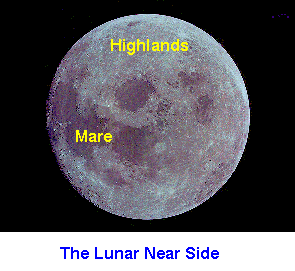
Here is a close-up showing how rough the highlands actually are:
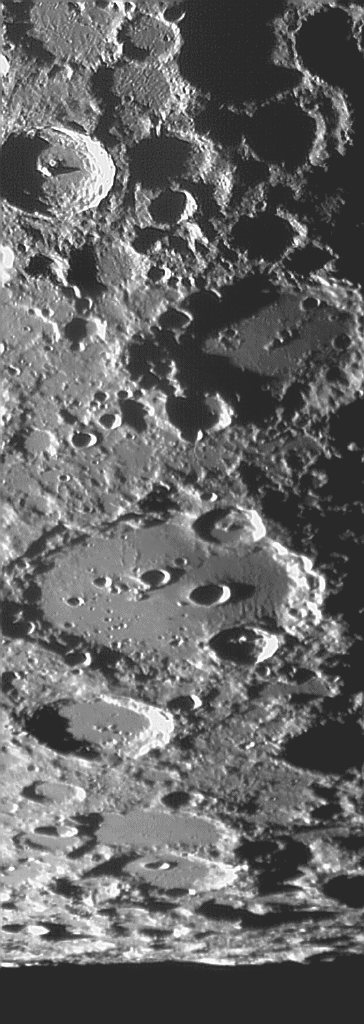
Craters upon craters! There was some trepidation in sending a manned mission into this region due to a fear that the surface would be too rough to safely land, but Apollo 16 targeted the highlands so that we could confirm the hypothesis that the highlands are older.
Here is a map of where the Apollo missions (green triangles) landed (as well as some unmanned probes. Click here for a bigger image):
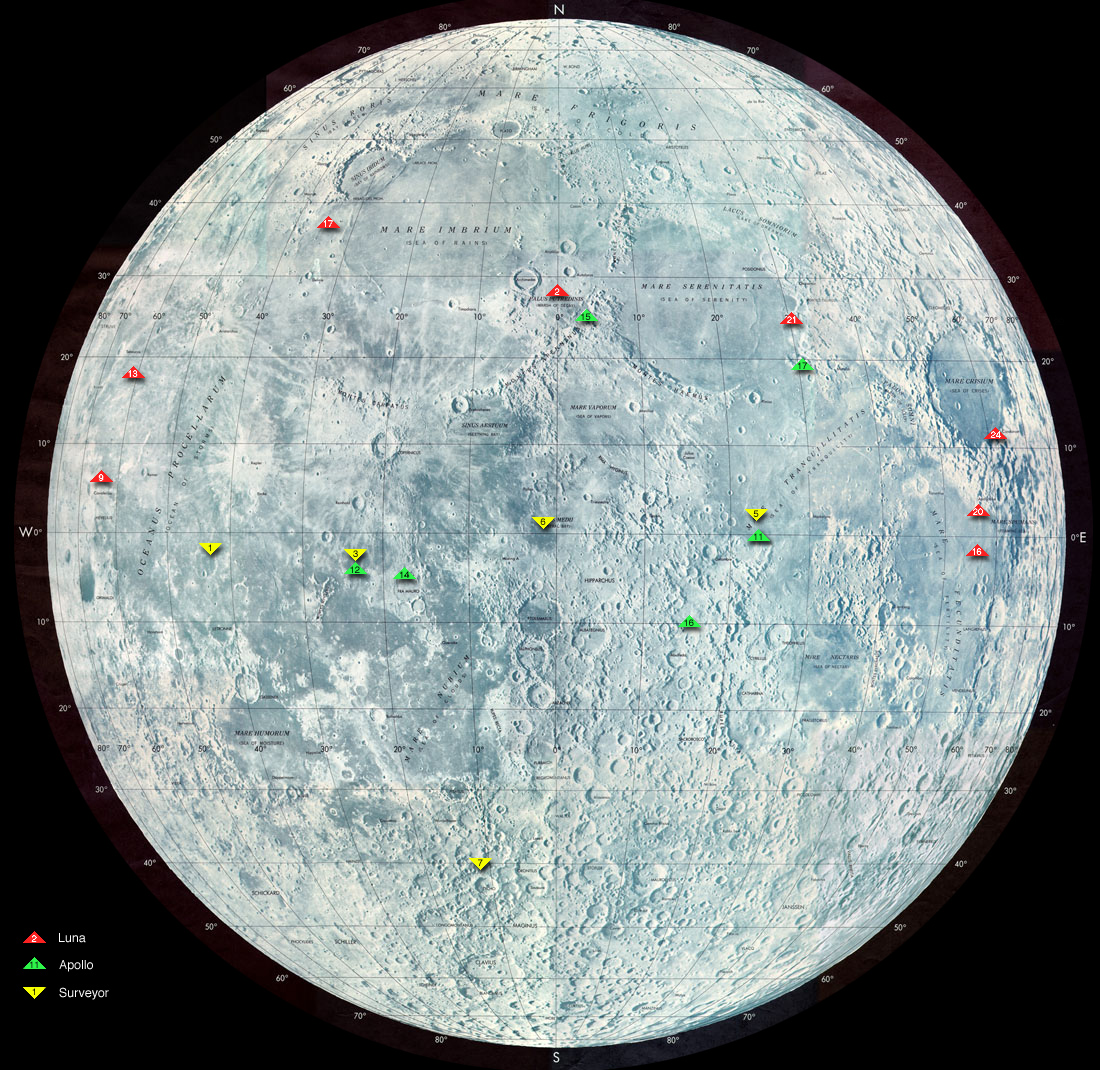
So, where did the Moon come from? Before the Apollo missions, there were four main theories about the origin of the Moon: 1) the fission hypothesis (Earth was spinning rapidly, and a large chunk broke off), 2) the "capture" theory (the Moon formed elsewhere, and was captured after coming too close to the Earth), 3) the "Condensation" theory (the Moon formed in place from material left over from the Earth's formation), or 4) the "giant impactor" theory (a huge body, about the size of Mars, hit the Earth, and the material liberated from the Earth's surface coalesced into the Moon). It is the last theory that is now believed to be correct. The fission theory requires a very rapid rotation rate of the Earth, and this is not observed. The lunar rocks also show evidence of tremendous heating. Not possible in the fission theory. The capture theory does not work because it is next to impossible to capture such a large body without perfect conditions. The lunar composition (low density of 3.34 gm/cm3) would imply that it had to form out near Mars (which has a density of 3.3 gm/cm3), migrate inwards, and get trapped by the Earth. Such a body would have too much energy to get captured by the Earth. The problem with the condensation problem was that if the Moon formed from the same material as the Earth, it should have the same overall density and composition. It does not, it has a lower density and is iron-poor. The giant impactor theory gets around all of these problems: the impact of a Mars-sized planet with the Earth would remove mostly crustal/mantle material that is low in iron, this explains the density. Analysis of the Moon rocks shows they have a similar composition to the crust/mantle of Earth. Finally, the tremendous heating apparent in lunar rocks can be easily explained by the heat of the impact. Here is an artist's view of the impact:
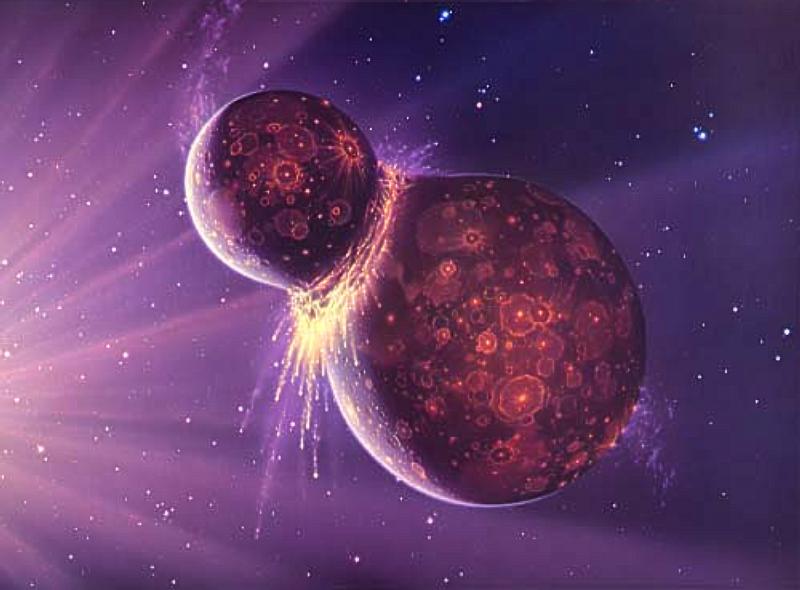
The material blasted from the Earth during this impact eventually coagulates and forms the Moon (for more on this theory, including new computer models, go here.). While the formation of the Moon was violent, not long after formation (a few hundred million years), the Moon became a much quieter place. As the bombardment phase of the early solar system ended, fewer and fewer impacts were occurring anywhere in the solar system. This was also true for the Moon. Because of its small size and low density, the Moon actually cooled very rapidly. Within a few hundred million years, the Moon started to solidify. In the early days, the Moon probably had a liquid interior. But now, the Moon is believed to be solid all the way to the core:
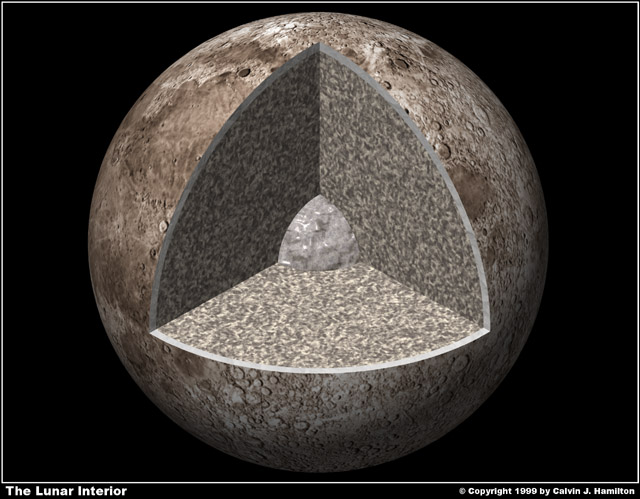
Here is a slice through the Earth (left) and Moon (right) showing the (to scale) sizes of the components that comprise the internal structure of the two bodies:
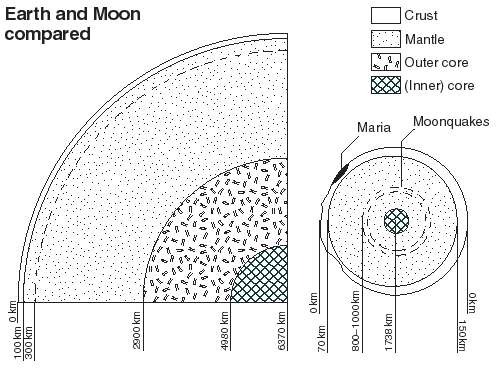
Because the Moon is completely solid, there is very little geological activity on the surface of the Moon. Any volcanoes the Moon had died-out shortly after it formed. To have volcanoes you need a hot, liquid interior. The Moon does not have this, thus the Moon's surface has remained relatively unchanged by geological activity for the last 3.5 billion years. Why doesn't the Moon have an atmosphere? The reason the Moon has no atmosphere is that it the gravity is too weak to hold on to any gases that might have been present during the time when the Moon had volcanic activity. The Moon and Earth are relatively close to the Sun, and the heat of the Sun warms the atmosphere, and it expands. The Moon's gravity is much too weak to hold onto an atmosphere. Thus, without erosion from wind and rain, the Moon's surface does not change (except for rare impacts).
One of the other consequences of not having an atmosphere is the extreme range in temperature experienced at the surface of the Moon. Without sheilding from the sunlight, the lunar surface is baked during the "day", reaching temperatures above the boiling point of water. During the nighttime, however, the temperature plummets to more than 200 degrees below zero! An atmosphere usually helps moderate the climate of a planet, but we will see in the next class that sometimes it makes things worse.